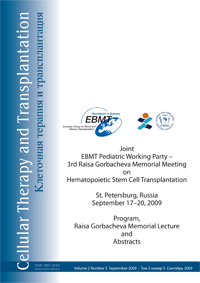Spirometry findings in bone marrow transplant patients
Larisa A. Kuzmina, Lidia S. Lubimova, Valeriy G. Savchenko
National Haematologic Scientific Centre, Russian Academy of Medical Sciences Moscow, Russia
Correspondence
Larisa A. Kuzmina, National Haematologic Scientific Centre, Russian Academy of Medical Sciences, Novozykovski pr., 4, 125167, Moscow, Russia, Phone: +7 (916) 148-71-31
E-mail: Kuzlara@rambler.ru
Summary
Aim
To investigate the frequency, character of spirometry findings, determine the prognostic of unfavorable alterations, and analyze responses on immunosuppressive therapy (IT) according to the character of spirometry findings in bone marrow transplantation (BMT) recipients.
Methods and materials
The spirometry tests were performed using the national spirometer SMP-21/01–«R-D» with a value of 15 standard tests. We included 54 recipients of allogeneic BMT: M/F 28/26, aged 17–45, AL – 30, and CML – 24. Myeloablative conditioning (MC) (BU 16 mg/kg+Cph 120 mg/kg) was used. Before BMT spirometry tests were performed in 28 pts during the first year, then 31, and later 32 pts. The total number of investigations was 185.
Results
The pulmonary functional alterations seen in BMT pts were as follows: restrictive, obstructive, and combined. After BMT the following alterations were revealed in 20 pts (32%): restrictive in 7, obstructive in 6, and bots (combined) in 7. During the first year restrictive alterations (50%) predominated. After 12 mo we generally observed obstructive and combined alterations (80%) in 70% of cases in pts with chronic graft versus host disease (GVHD). There were no adequate correlations between the spirometry results before BMT and the early period after BMT and the later development of severe lung complications. In those patients that presented restrictive alterations, significant clinical symptoms of pulmonary insufficiency in the majority of pts was not observed: IT was successful. In those patients that presented obstructive alterations, we only observed the improvement or the stabilization of the process in a minority of pts by using a combined long IT. In 6 of the 8 pts with the most severe clinical symptoms – i.e., apnea and oxygen dependence – there were combinate alterations; IT was unsuccessful.
Conclusion
Spirometry is an important method for the definition of the IT strategy in accordance with recognized alterations, especially after 6 mo when GVHD prophylaxis is over. Regular examinations are of great importance, especially in patients with chronic GVHD.
Keywords
spirometry, bone marrow transplantation, BMT, pulmonary complications/ mortality, myeloablative conditioning, MC, graft-versus-host disease, GVHD, immunosuppressive therapy, IT


